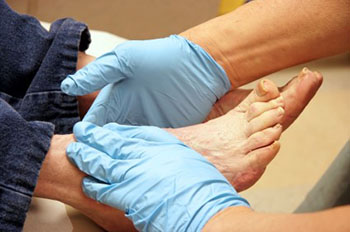Welcome to Tri-County Foot & Ankle
Diabetic Foot Care

Diabetic Foot Care
Diabetic foot care is critical to the millions of people diagnosed every year and one of our top priorities at Tri-County Foot & Ankle. Blood vessels located all over the body are damaged due to diabetes – even the blood vessels of the feet. Neuropathy, or nerve damage, can result from slower blood flow in the legs and feet. In diabetic patients, neuropathy is very important to monitor as diabetics are at risk for developing ulcers.
Treatment
Always washing and thoroughly drying the feet are pertinent parts of diabetic foot care. There should be a focus on cleaning between the toes. Even if no pain is felt, the entire foot should be examined for redness and sores. Neuropathy can often mask the pain of sores and ulcers, and cause these conditions to be overlooked. Use a mirror to examine the underside of your feet if needed. It is recommended that diabetics wear well-fitting socks.
Patients with diabetes should have their TCFA doctor monitor their blood levels because blood sugar levels play a huge role in diabetic care. Monitoring these levels on a regular basis is highly advised. It is very important to keep your blood sugar levels in the normal range, which can be determined by your physician. There are medications that a physician may prescribe to help with neuropathy of the diabetic patient. It is also advisable to visit a podiatrist if the diabetic patient is experiencing any conditions involving the feet such as ingrown toenails, which in more severe cases can cause infection.
Diabetic foot care at home is possible if a patient is provided with instructions from their physician. Patients can cure dry heels with creams or ointments. If trying to remove a callus with a tool, practice caution as severe diabetics may not be able to feel pain. Improper removal may cause a wound to develop.
Exercise is crucial when it comes to dealing with diabetes. Extra precautions need to be taken for people with diabetes compared to those without it. A doctor must always be consulted if a person with diabetes wants to change his exercise routine. For diabetics the best time to exercise is one to three hours after eating, when blood sugar levels are at their highest point. It is important for diabetics to test their blood sugar levels before exercising. Having a small snack can raise low blood sugar levels and prevent hypoglycemia. Diabetics should also wear medical alert bracelets while they exercise and carry glucose tablets in case of emergency.
Diabetic feet must be inspected on a daily basis. Set up regular visits with your podiatrist since proper diabetic foot care is necessary. If you suspect that you have a wound, notify your doctor immediately. Gangrene is a serious problem for diabetics and can lead to sepsis and amputation in its worst cases. It is also important for diabetics to be on the lookout for ulcers. Ulcers are sores that develop from tissue loss on the skin. They can be quite painful and require intensive treatment. If there is a wound, diabetics should wash the wound with saline or clean water. Applying an antibiotic ointment and covering with a bandage is also important. However, these solutions are only temporary and you should see a podiatrist if you have a foot ulcer. Early treatment and daily inspection of diabetic feet are keys to staying healthy.
